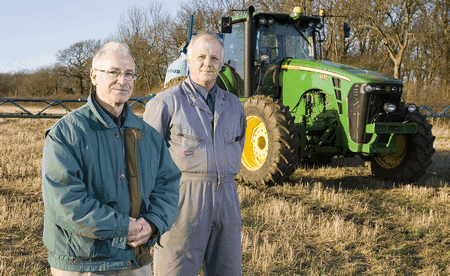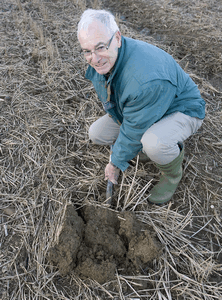Controlled traffic farming – can it work in the UK?
Controlled traffic farming systems are used in other parts of the world. Mike Abram in the February issue of Crops investigates whether they would work in the UK.
In theory, controlled traffic farming – a system that confines all field vehicles to the same permanent traffic lanes each and every year – seems like an obvious idea. Being able to restrict traffic to the same parts of the field improves soil structure on the rest of the field with knock-on benefits for yield and a reduction in machinery costs, say system enthusiasts.
But there are plenty of question marks over its practicality for farmers:
- How easy is it to return year-on-year to the same traffic lanes?
- What specialist equipment do you need, and how expensive is it?
- How do you marry up equipment with different wheelbase widths?
- And what about harvest – can you still load trailers on the move in the field?
They are all valid questions, Tim Chamen of Controlled Traffic Farming (Europe) admits. Answering them is part of a four-year project CTF (Europe), along with industry partners, is running at Unilever‘s Lee Farm, Colworth in Bedfordshire, managed by Andy Coggins.
“The first step [for farmers interested in going to controlled traffic] is mindset,” Mr Chamen says. “They need to say to themselves ‘I want to do this’. Once they’ve done that, they can start to come up with their own systems to suit their farm. Farmers are pretty clever about working out what works.”

Controlled traffic doesn’t have to be complicated you don’t even need global position satellite technology, he says. “It is possible to do it with a mechanical marker system with very skilled labour.”
In reality few farmers could or would contemplate controlled traffic without GPS, Mr Coggins says. “The management is just too much.”
A practical guidance system makes life much easier. But there are drawbacks to some of the systems on sale. Cheaper versions with a GPS satellite-based correction signal, are great for providing pass-to-pass accuracy to within ±10cm. Typically, a guidance system of this nature with one receiver, swapped between a harvester and tractor, which are both equipped with auto-steer, costs about £16,000.
But with satellite correction the field positioning is not repeatable every time you go back to the field – a bit of a problem for controlled traffic farming. It means a permanent mark is required on every pass to make sure the equipment stays in place.
That is the system Mr Coggins is using in the project. “It will give real deviation at times, which is why we have to be more skilled at fine-tuning. But on the whole I think it has been very accurate.” The main problem he has found is with the human eye thinking the system is out when it might not be, or vice versa.
Using a system with a GPS ground-based correction signal (RTK) should take that worry away. “It puts you back in the same spot to an accuracy of 2-3cm,” Mr Chamen says. 
RTK-guidance systems cost about £12,000 extra, but that can be justified, CTF (Europe) calculations show. Without CTF, overlap savings – from tillage, drilling, combining and spraying – on a 500ha farm using minimum tillage (two passes plus sub-soiling once every four years) from using a satellite-corrected pass-to-pass guidance system are about £16/ha.
Moving to a full-blown CTF system with RTK will marginally increase overlap savings from the increased accuracy to about £18/ha. But the bigger savings will come from being able to reduce tillage operations, Mr Chamen suggests. “The minimum you should be able to knock off is one pass.”
That is because soil structure on the non-trafficked area will improve through less compaction and need less tillage to make a seed-bed (see panel). Often it can be direct-drilled, Mr Chamen says. And what cultivation is required should be easier, as the soil will lift up easily because it has not been squashed down by wheels, meaning lower-power tractors and less fuel.
Sub-soiling should only be necessary on tracked areas outside the main permanent tracks (which they aim to fill, not loosen), again cutting costs. Mr Chamen calculates tillage savings on a 500ha farm to be worth about £31/ha, in addition to the pass-to-pass savings. Add in an 8% yield increase (a conservative estimate based on research from UK and other countries), worth another £36/ha, and suddenly controlled traffic appears better value.
Table 1: Cost & return comparison for guidance systems
|
System |
Costs |
Returns/ha |
|
|||
|
|
|
Overlap savings |
Tillage savings |
Yield incr. |
Net return |
% overlap ROI |
|
Min-till plus parallel tracking |
£16,437 |
£16.29 |
– |
– |
£16.29 |
16 |
|
Min-till plus TRK and CTF |
£28,706 |
£18.28 |
£31.17* |
£35.91 |
£74.71 |
-1 |
- £10.65 of this saving should be offset to fund a 15% return on capital investment
- Costs calculated on 500ha farm with beans, wheat and oilseed rape
Source: CTF (Europe)
Table 2a: Predicted improvements using pass-to-pass and RTK guidance
|
Operation |
Units |
Primary Tillage |
Sub-soil |
Spraying (no tramlines) |
|
Hectares cropped |
ha |
500 |
150 |
300 |
|
Implement width |
m |
6 |
6 |
24 |
|
Overlap without guidance |
cm |
50 |
25 |
100 |
|
Overlap with pass to pass guidance (% reduction) |
cm |
10 (7%) |
10 (6%) |
10 (6%) |
|
Overlap with RTK guidance (% reduction) |
cm |
3 (8%) |
3 (4%) |
3 (4%) |
|
Labour productivity without guidance |
ha/hr |
3.74 |
2.93 |
28.98 |
|
Labour productivity with pass to pass guidance |
ha/hr |
4.01 |
? |
30.11 |
|
Labour productivity with RTK guidance |
ha/hr |
4.06 |
3.04 |
30.2 |
|
Passes / yr |
|
2 (P2P) 1 (RTK) |
1 |
1 |
Table 2b: Predicted improvements using pass-to-pass and RTK guidance
|
Operation |
Drilling |
Spraying (tramlines) |
Combining |
Fertiliser (tramlines) |
|
Hectares cropped |
500 |
500 |
500 |
500 |
|
Implement width |
6 |
24 |
6.1 |
24 |
|
Overlap without guidance |
20 |
75 |
60 |
75 |
|
Overlap with pass to pass guidance (% reduction) |
10 (2%) |
25 (2.1%) |
10 (8%) |
25 (2%) |
|
Overlap with RTK guidance (% reduction) |
3 (3%) |
3 (3%) |
3 (9%) |
3 (3%) |
|
Labour productivity without guidance |
4.64 |
29.3 |
2.06 |
33.48 |
|
Labour productivity with pass to pass guidance |
4.72 |
29.93 |
2.25 |
34.20 |
|
Labour productivity with RTK guidance |
4.78 |
30.2 |
2.28 |
34.52 |
|
Passes / yr |
1 |
7 |
1 |
3.5 |
|
Does controlled traffic farming have a future in the UK? and have your opinion on FWispace. |
Go back to the controlled traffic farming landing page.

